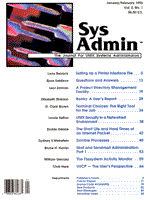
Sidebar: Panasonic Printer Interface Codes
The Bourne shell code in Listing 1 is extracted from a printer interface file for the Panasonic KX-P1180, a small dot-matrix printer. It recognizes several codes that can apply to an entire document, and a couple of codes that might be useful for some documents, even if they are not widely applicable. Instead of the "standard" file, however, I chose to modify one of the other files, named "dumb." It is a minimal printer interface definition that is a good place to start when all the facilities of the standard file are not needed. Several variables are defined at the top to have numerical codes that correspond to the actual codes the printer uses. This allows the variable names to be plugged directly into the command string. Notice that some of the variables are initialized with the word "no" and others are initialized in terms of other variable settings. Then the loop that evaluates the options variable begins. The nlq and tab4 variables are simple options set by using -o nlq or -o tab4. The font and justify options are value-setting options, which could have any of the names listed as NLQ fonts or Justification codes. It uses the parse function discussed in the text, but it also uses a technique I found for working with meaningful names instead of requiring magic numbers. By using the syntax
font=`eval echo $"$font"`
the current value set in the font variable by the parse function will be output within the quotation marks. The quotation marks will be stripped when the substitution surrounded by back-quotes is evaluated. Thus, that quoted name will become a variable because of the $ placed before the open quotation mark, so the value associated with that name, now a variable, is delivered to the echo command. So, if -o font=sansserif is used, the first pass becomes
font=`eval echo $sansserif`
which becomes
font=1
letting the computer remember the magic number and the user remember the font name. The same logic is used with the justify option. The other options take advantage of the fact that this printer can combine several enhancements in a single, bit-encoded command. Pica is default 0, and mutually exclusive with elite, but the rest -- proportional, compressed, emphasized, double-strike, wide, italic, and underline -- may all be possible in any combination. If you combine them into a single variable, progpitch (for programmable pitch), they can be output at once. When the options are all determined, the code first resets the printer, then sets up the NLQ operation, if needed. These steps are done with the echo command, since everything that goes to stdout will get to the printer. These commands take advantage of echo's ability to embed octal codes in the string (recall that the \c code tells echo not to output a newline after the string). The second echo of the NLQ string sequence embeds the font variable. For the programmable pitch variable, there was a small problem. The printer needed the command expressed as a binary value (which echo can do as an octal value), not the decimal value expressed by echoing a variable. By running it through the printf() function in awk (a little overkill, but it worked), I could convert it to the octal form needed. The echo program is pretty particular about this format, too, wanting to see that leading zero in the octal number no matter what, so a zero had to be specifically put into the echo. (The awk descriptor could have been made %04o instead.) After this code comes the loop that outputs the copies to the printer. This fragment should give some ideas on how to handle some of the special capabilities offered by most of the more advanced printers available today.
|